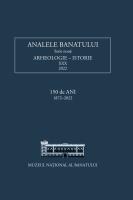Situri și descoperiri de epocă romană din împrejurimile Potaissei (VI). Date noi și clarificări privind partea de est a teritoriului municipiului Turda
Roman sites and discoveries around Potaissa. (VI). New data and clarifications regarding the eastern side of the territory of Turda Municipality.
Author(s): Andrei-Cătălin DîscăSubject(s): Archaeology, Local History / Microhistory, Ancient World
Published by: Editura Mega Print SRL
Keywords: archaeological mapping; Roman age sites; Potaissa; Provincia Dacia; Turda;
Summary/Abstract: In 106 A.D. the kingdom of Decebalus was conquered by the roman emperor Trajan and upon its ruins was created the Roman province of Dacia. In about one century and a half the newly created province was so deeply transformed, that when Dacia was abandoned by the Roman administration around 275 A.D., the material culture dominating this area was the Roman one. These transformations are well illustrated by two Roman sites located several kilometres northwest of the junction between the Arieș and Mureș Rivers, namely the town of Potaissa and the legionary fortress of Legio V Macedonica. In the area where these two sites are located, only a small indigenous settlement is presumed to have existed prior to the Roman conquest. Nonetheless, at the end of the second century A.D., both the town of Potaissa, and the legionary fortress reached their peak, making this area of the highest importance for Roman Dacia. For this reason, these two sites were intensely investigated by the scholars over the last decades. As testimony to the intense processes of colonisation, urbanisation and Romanisation undertook in Dacia until the last quarter of the third century also stands the high number of settlements which developed during the Roman period around Potaissa. Most of these settlements are located to the south and west of the present municipality of Turda, towards Cheia, Săndulești and Copăceni villages, but there are also some settlements to the north and east. In the eastern side of the territory of Turda municipality the literature mentions three archaeological sites in the areas known as “Valea Sărată”, “Izvorul Sf. Ioan”, and “Valea Florilor”. In contrast with Potaissa and the legionary fortress of Legio V Macedonica the large majority of the numerous settlements which developed around the abovementioned town and fortress were investigated to a much lower degree. In the current state of research are lacking essential data about these settlements, as for example: their exact locations, dimensions and archaeological inventories. To improve the current state of research it is necessary to sum up the information from the literature, to conduct new field surveys in this area and to create accurate maps with all the sites and discoveries. These are the goals of a project that started a couple of years ago and envisaged all Roman-Era sites around Potaissa. Starting with 2019 the results of this project have been published in a series of studies, the present study, dealing with the Roman age sites located in the eastern side of Turda municipality, belonging to this series.
Journal: Analele Banatului S.N. Arheologie-Istorie
- Issue Year: XXX/2022
- Issue No: 1
- Page Range: 71-90
- Page Count: 20
- Language: Romanian

